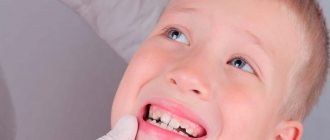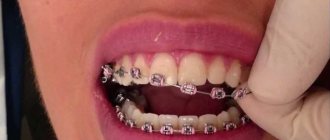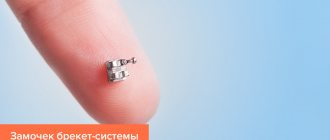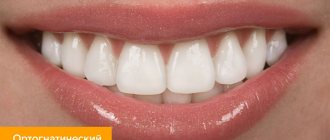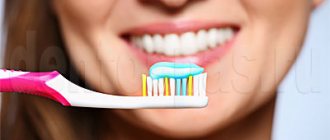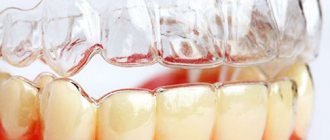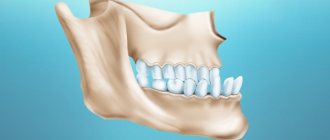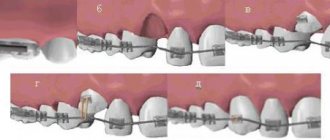Bite defects often lead to various kinds of complications. To correct the bite, braces are worn. However, braces are not suitable for everyone; many are embarrassed to wear metal “decorations” on their teeth. Orthodontists offer an alternative to braces - dental simulators. The T4K trainer and other types of orthodontic devices will correct the bite and straighten the smile line, and they do not have to be used constantly. Let's look at the types of trainers and their use in orthodontics.
What is the device?
A pre-orthodontic trainer is one of the types of elastopositioners that are used in orthodontics .
It is of greatest relevance for the correction and correction of various disorders of the maxillofacial structure and development of children, since its work is aimed largely at normalizing muscle activity.
When used correctly and in a timely manner, this design makes it possible to eliminate and eliminate the multiple effects of harmful childhood habits such as thumb sucking, poor articulation or swallowing.
All this despite the fact that the muscular frame of the face is loose and contributes to the improper development of the dental system and adjacent organs, for example, ENT organs.
Design features
The design of the device is simple. It is a two-jaw mouthguard, which is essentially a kind of cover for the dentition.
All components of the device perform a specific function, which, together with others, helps to completely correct the situation with malocclusion at an early age.
The T4K trainer provides:
- recesses for teeth;
- labial (labial) arches from the outside;
- special tongue;
- on the inside - a tongue stop;
- lip bumper.
How to correct a distal bite, read in a new publication.
We will tell you here what an orthodontist treats. What problems does a dentist in this specialty solve?
In the link we will talk about how effective myogymnastics is for distal occlusion.
Varieties
The device has two varieties, which are completely identical in their structure and design, but differ in material parameters.
- Initial .
Painted in light blue, the T4K Trainer is soft and flexible. Its flexibility ensures rapid adaptation to most pronounced changes in the dentition, manifested in non-closing of the jaws, that is, disocclusion. The main purpose is to eliminate myofunctional problems (associated with improper functioning of the facial and cranial muscles) and bad habits, including mouth breathing. - Final. Painted in pink (red) color, more rigid. In many ways, its action is carried out on the principle of using wire arcs.
It is intended as the second stage of treatment, immediately following the use of the first version of the trainer.In some cases, when the severity of disocclusion is minimal, the doctor may prescribe wearing a pink trainer at the first stage.
Characteristics
Both types of T4K pre-orthodontic trainer are made of elastic material. For this purpose, silicone with color additives is used for easy identification of models .
The only difference is that a harder silicone is used to make the final trainer.
The material is hypoallergenic, which is especially important when using it to treat children. Silicone has so-called shape memory. This allows the trainer to quickly adapt to the individual characteristics of the patient.
This makes it possible to use T4K in a universal size , rather than wait a significant amount of time for individual production, since the adjustment is minimal and takes a minimum of time.
Also, the material, despite its relative flexibility and elasticity, has a large margin of strength. This makes it possible to carry out treatment using only one trainer, rather than replacing it, such as mouth guards.
Advantages and disadvantages
The advantages of T4K trainers are numerous:
- Strength and durability.
- Hypoallergenic.
- Comfortable and easy to wear.
- Almost complete absence of discomfort in children when wearing.
- Can be used to correct most malocclusions.
- Relatively short treatment period.
- Ensuring the child’s psychological comfort, since the device is not worn during games and communication with peers, accordingly, the correction of violations occurs unnoticed by others and the child is spared ridicule.
- Two small holes in the front section of the device make it possible to continue use even in cases of severe rhinitis.
disadvantages . The main one is to correct only relatively uncomplicated cases when there is no need for precise movement of each tooth .
In addition, the disadvantage is that for the success of treatment it is necessary to strictly follow the recommendations and maintain accuracy in wearing time . When used by children, this can sometimes be quite a difficult task.
Design features
Parts of the device are fixed on the lower and upper row of teeth due to a recess in the material.
Among the other elements that make up the design are:
- pterygoid base;
- lip bumper;
- tongue limiter;
- labial arches;
- tongue;
- silicone tubercles.
The structure of the trainer helps achieve proper closure of the jaws, and also affects the growth of teeth and restores the orbicularis oris muscle.
In what cases trainers are appointed, find out from the video material.
Who is it suitable for?
T4K trainers have a strictly defined area of application. It is intended to treat children aged 5 to 12 years .
Indications
- Crowding of teeth in the central part of the lower jaw.
- Deep bite.
- Open bite (central area).
- Engle class II (subclasses 1, 2).
- Angle's I class - crowding.
- Mild Angle class III.
- Various bad habits: improper swallowing, speech problems, mouth breathing, thumb sucking.
- Unnatural position of the lower jaw.
Contraindications
- Pronounced Angle class III.
- Pathological nasal congestion (obstruction of the nasal passages).
- Pronounced conflict between children and parents.
- Cross bite (lateral parts of the jaws).
Advantages compared to braces
Orthodontists and their patients note the advantageous features of the devices relative to braces:
- no age restrictions. Trainers can be used from the age of 5, after a temporary bite has formed;
- removable design. Thus, during the daytime the child feels free to communicate with peers;
- the trainer materials are soft enough and do not rub soft tissues in the oral cavity;
- trainers correct defects in childhood more effectively;
- there are practically no contraindications;
- hygiene procedures are not difficult;
- The cost of treatment with trainers is lower than when installing braces.
- models do not require individual adjustment.
From the video you will learn more about the advantages of treatment with trainers compared to correcting abnormalities with braces.
What effect does it have?
Each structural element performs a specific function, which is necessary to correct the bite as a whole.
- Labial arches in T4K are somewhat different from similar devices for adults - they are less high. This element helps the fangs take the correct position in the dentition, especially when they erupt.
- The slightly shortened design of the children's appliance not only provides comfort and ease of wearing, but also provides support for the seventh teeth in a row.
This ensures their correct position in relation not only to neighboring teeth, but also to antagonists located on the opposite jaw. - A special tongue helps the child to correctly position his own tongue, especially its tip.
It is the position of the tongue in the mouth at the stage of formation of the dental system that can affect the location and growth of teeth. Here the tongue is a protruding part that constantly reminds the baby of itself, as it touches the tongue. Accordingly, this element is active. - The recesses provided by the design position the teeth in the correct position - a row. They work, despite the relatively soft material, like wire arches used in orthodontics.
- Labial arches allow you to involuntarily relax individual muscles that are tense in case of malocclusion. Relieving excess stress allows the teeth to return to their normal position.
- Separately, it should be noted small protrusions on the inside of the labial arches , which exert a certain (minimal, but sufficient) pressure on uneven front teeth, thereby provoking a correction of their position.
The entire structure provides overall bite correction. This is facilitated not only by fixation of the dentition, but also by the anatomically correct and natural position of the tongue, limitation of its movement, stimulation of normal breathing through the nose and marginal closure.
How to choose a treatment method for open bite in children? What are the methods used?
In the next article we will discuss which orthodontic trainers are used for children.
Read the link https://www.vash-dentist.ru/ortodontiya/prikus/perekrestnyiy-opisanie-patologii-i-sposobyi-lecheniya.html about the features of correcting crossbite at different ages.
Bite defects in children
Children and teenagers often develop malocclusion, which is caused by incorrect positioning of the tongue and lips. If the baby is raised on artificial nutrition or has used a pacifier for too long, a malocclusion is guaranteed. Incorrect position of the lips and tongue is caused by the habit of putting the thumb in the mouth during sleep or during the day, and the habit of pulling various objects into the mouth.
Parents must promptly recognize the onset of malocclusion in order to take timely measures. Signs of developing pathology are:
- irregular face oval;
- separation of teeth in different parts of the jaw;
- parted lips;
- protruding tongue forward when swallowing;
- pathologies of teething;
- grimaces.
An irregular oval of the face can be noticed immediately: the face takes on an elongated shape or the lower part looks shortened. In profile, the head looks convex or concave. Often a child develops asymmetry: one part of the face visually looks larger than the other. The cause of the deformation may be a jaw that is too small or too large, or an abnormal inclination of the teeth.
How to determine the separation of teeth in a child? You need to ask the baby to close his teeth. With a properly formed bite, the upper teeth slightly cover the lower ones. If the upper teeth protrude forward (more than 1/3 of the length), this indicates pathology. The causes of this pathology can be bad habits: the position of the tongue between the upper and lower teeth, the inability to breathe through the nose, or prolonged pacifier/thumb sucking.
Parted lips are easy to notice - the baby constantly walks with his mouth open. If you ask a child to close his mouth, muscle tension can be seen. The cause of this pathology is mouth breathing or loose teeth.
When pushing the tongue forward during swallowing, the child constantly rests the tip of the tongue on the lips instead of the front teeth. This pathology is a consequence of the infantile type of swallowing inherent in infants. If the pathology is not corrected, multiple orthodontic problems may subsequently develop.
Grimaces on a child’s face appear when the facial muscles are overly tense. Characteristic folds appear on the cheeks and near the lips, and the chin becomes tense.
Pathologies of teething can be due to improper feeding (only liquid and pureed foods are on the menu) or due to injury to the jaw. The child may not have teeth for a long time, or the molars may begin to grow in the wrong position.
Recommendations for use
One of the features of T4K trainers is that they are put on (installed) independently by the patient . Neither the doctor nor the parents should physically help with this.
However, it is mandatory to provide detailed explanations to the child about exactly how to position the device itself in the oral cavity and where the tongue should be.
Instructions for use
Correct installation and positioning of the device in the mouth are mandatory conditions for successful treatment.
After detailed explanations, you should make sure that the child remembers everything correctly and performs it exactly.
- Remove the device from the box.
- Position it so that the center tab points upward.
- Place the device in the oral cavity.
- Use the tip of your tongue to touch the marker tab.
- Gently clench your teeth until a slight sensation of pressure appears in the central region.
- Close your lips completely so that you breathe through your nose.
Regularity of wearing
Be sure to wear the trainer every day. It applies minimal pressure, so missing even one session can affect the outcome of treatment.
During the day, you need to wear the device for one hour (continuously), as well as throughout the night.
Care
must be rinsed with clean, lukewarm water after each use , that is, in the morning after overnight and each time after removal during the day.
After cleaning the device, it must be placed in a container specially designed for this purpose. Sometimes it is desirable to carry out a more thorough cleansing using a very soft toothbrush of a regular design and a toothpaste with reduced abrasiveness.
If any mechanical damage is found on the surface, you should immediately contact your doctor for advice on the possibility of further wearing this device.
Watch the video about the benefits of using trainers at an early age:
Duration of treatment
As with the use of any other orthodontic devices and structures, the duration of treatment with the T4K trainer is difficult to determine exactly. This depends on the severity of the anomalies and various individual characteristics of the patient’s body.
also a dependence of the treatment period on the specific type of device - initial or final .
We can only give approximate dates.
For the initial blue trainer they are about 6-8 months, and for the final pink trainer they average about 9 months. These numbers are subject to change. For example, the final stage can last from six months to a year or even a little more.
Cost of dental trainers
The price of dental trainers is much lower than installing braces or surgical treatment. The amount varies from 2000 to 6000 rubles. Before using the device regularly, you will definitely need to consult a specialist, which can be done in a private office or clinic.
Dental trainers should only be used regularly if prescribed by a doctor. The specialist will determine a list of physiological disorders and also assess the prospects for treatment.
This article is for informational purposes only, please consult your doctor for details! Ask your doctor about contraindications and side effects.
Reviews
The majority of patients and their parents are satisfied with the results of treatment using the T4K pre-orthodontic trainer. Everyone notes its convenience and ease of use, as well as greater efficiency.
You can share your experience of using both types of this device by leaving a comment below.
If you find an error, please select a piece of text and press Ctrl+Enter.
Tags: bite correction, bite trainers for children
Did you like the article? stay tuned
Previous article
Dental varnish: how does it work, who is it suitable for?
Next article
Deep bite: general information
Characteristics
The use of the T4k trainer allows you to straighten the bite, eliminating the recurrence of pathology in the future.
This design is completely safe for children, since the materials are plastic and do not have a toxic effect.
One of the important characteristics is that the device does not harm the enamel.
Since the treatment is carried out in two stages, the manufacturer labels them using color additives.
The elasticity of the materials makes getting used to wearing it short and easy for the little patient.
The trainer is durable, so there is no need to replace it either at the first or second stage of treatment.
Definition
T4A is a two-jaw single design designed to correct misaligned teeth and abnormal bites. The device is made of transparent elastic plastic , which does not injure or irritate periodontal tissue and crown enamel.
Its appearance is completely different from standard orthodontic devices - there are no metal arches, plastic base or elements that tightly grip the teeth.
The trainer is a multifunctional device that can not only align single crowns, but also eliminate the causes of incorrect bite formation, as well as its consequences.
The device includes two actions at once: mechanical and functional, which can significantly shorten the treatment period without the use of complex devices.
Term
The duration of wearing trainers will directly depend on the primary pathology and the cause of its occurrence.
When correcting myofunctional habits, the device will have to be used for 3 to 6 months. In the process of correcting minor crowding or abnormal crown growth, noticeable results can be seen within 2 months.
At some point, progress may stop. This means that it is necessary to install a more rigid trainer, which must be worn for at least 3 months. On average, the treatment period with these devices ranges from 6 to 9 months.
To ensure the fastest results, you need to wear the trainers daily, first putting them on during the day for 1 or 2 hours, and then throughout the night . If using the device results in severe discomfort or pain, it is recommended to switch to it gradually.
It is best to start with one hour during the day and several hours at night. This will increase the total treatment period, but will reduce the negative manifestations that often arise during treatment with trainers.
Treatment
When choosing trainers as the main method of correcting an uneven row of teeth, the patient’s desire alone is not enough. The decision to treat with T4A should be made by the dentist after a thorough examination.
In order to identify an accurate picture of the pathology, the doctor prescribes hardware diagnostics to obtain detailed detailed images of both jaws. If a patient is diagnosed with a deep, distal or moderately deviated open bite, then wearing trainers is prescribed.
Also, the choice is made on this device if the position of single crowns is defective. In other cases, braces are preferred.
Look at the photos to see what mouth guards are available for teeth straightening.
How much do teeth straightening plates cost? Here is the average price in Russia.
Here https://zubovv.ru/ortodontiya/diastemyi-i-tremyi/shhel-mezhdu-perednimi-zubami.html ways to fix the gap between the front teeth.
Rules of care
The main care of trainers consists of their timely cleaning and proper storage .
Each time after use, the structure must be cleaned with a toothbrush and toothpaste. After this, be sure to rinse the device under running water until the cleaning agent is completely removed.
It is prohibited to treat the product with boiling water or substances that have an aggressive effect on its surface.
The mouth guards must be stored in a closed container that is free from dust and dirt.
Antibacterial cleaning of the device is carried out only with specially designed products..

